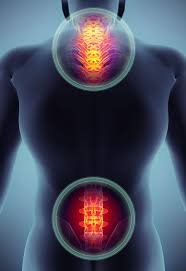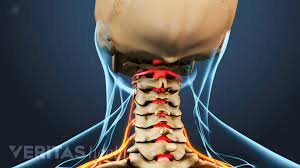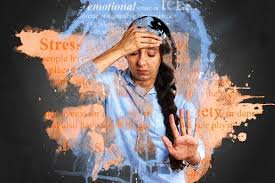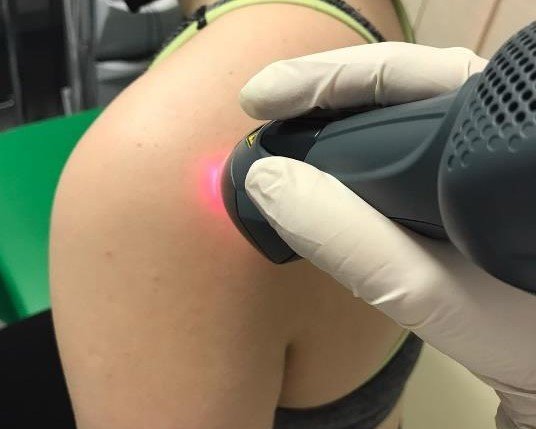Treating & Managing Lumbar Radiculopathies
Lumbar radiculopathy occurs in the lower region of the spine and is associated with sciatica pain. The lower back is the most common area affected by radiculopathy.
Evaluation techniques and a detailed diagnostic & treatment system can identify the pathology and treatment that has demonstrated streamlined decision making and better results.
Learn the examination and treatment of the lumbar spine using a full system, which is clinically proven to elicit better functional outcomes.
Treating & Managing Cervical Radiculopathies
Millions of people suffer from symptoms such as neck and back pain, cervicogenic headaches, and migraines that can be effectively addressed by a Chiropractor. Evaluation techniques and a detailed diagnostic & treatment system can identify the pathology and treatment that has demonstrated streamlined decision making and better results.
Learn the examination and treatment of the cervical and upper thoracic spine using a full system, which is clinically proven to elicit better functional outcomes.
The Impact of ACE's on Health Outcomes: Trauma Informed Care in Chiropractic
Trauma informed care (TIC) is a recommended approach to healthcare delivery across professions, especially when a trauma history is suspected. This program aims to introduce TIC concepts as they may apply to chiropractic care for adults with a history of Adverse Childhood Experiences (ACEs). Prior trauma can lessen trust, alter perceptions of physical touch, and hands-on examinations and chiropractic treatments may trigger stress responses.
ACEs can facilitate chronic stress. Chronic stress leads to an increase in stress hormones (adrenocorticoids), held in a dynamic equilibrium by allostasis . Chronic stress generates allostatic load, straining body systems and causing physiological change.
All of the effects of chiropractic care on this population are well documented throughout the literature and through studies. Join us to learn how Chiropractic can help these patients and how you as a Chiropractor can have a major impact on their ability to function.
Treating & Managing Cervical and Lumbar Radiculopathies
Symptoms of Cervical and Lumbar radiculopathies range from simple pain to paresthesias, or weakness or much more. Differentiation of neuropathic vs nociceptive vs nocioplastic pain syndromes is essential in deploying the proper treatment regime.
Proper evaluation of your patient experiencing these symptoms is essential. Detailed diagnostic & treatment systems can identify the pathology and treatment getting better results.
In this seminar, you’ll learn:
1. The examination process for each area: cervical, upper thoracic, lumbar spine
2. Treatments and treatment protocols for these areas using a full system.
3. How you can apply what you learn in your office the next day and elicit better functional outcomes for your patients
4. A comprehensive review of the current research for each condition.
Treating & Managing Cervical and Lumbar Radiculopathies
Symptoms of Cervical and Lumbar radiculopathies range from simple pain to paresthesias, or weakness or much more. Differentiation of neuropathic vs nociceptive vs nocioplastic pain syndromes is essential in deploying the proper treatment regime.
Proper evaluation of your patient experiencing these symptoms is essential. Detailed diagnostic & treatment systems can identify the pathology and treatment getting better results.
In this seminar, you’ll learn:
1. The examination process for each area: cervical, upper thoracic, lumbar spine
2. Treatments and treatment protocols for these areas using a full system.
3. How you can apply what you learn in your office the next day and elicit better functional outcomes for your patients
4. A comprehensive review of the current research for each condition.
Treating & Managing Cervical and Lumbar Radiculopathies
Symptoms of Cervical and Lumbar radiculopathies range from simple pain to paresthesias, or weakness or much more. Differentiation of neuropathic vs nociceptive vs nocioplastic pain syndromes is essential in deploying the proper treatment regime.
Proper evaluation of your patient experiencing these symptoms is essential. Detailed diagnostic & treatment systems can identify the pathology and treatment getting better results.
In this seminar, you’ll learn:
1. The examination process for each area: cervical, upper thoracic, lumbar spine
2. Treatments and treatment protocols for these areas using a full system.
3. How you can apply what you learn in your office the next day and elicit better functional outcomes for your patients
4. A comprehensive review of the current research for each condition.
The Impact of ACE's on Health Outcomes: Trauma Informed Care in Chiropractic
Trauma informed care (TIC) is a recommended approach to healthcare delivery across professions, especially when a trauma history is suspected. This program aims to introduce TIC concepts as they may apply to chiropractic care for adults with a history of Adverse Childhood Experiences (ACEs). Prior trauma can lessen trust, alter perceptions of physical touch, and hands-on examinations and chiropractic treatments may trigger stress responses.
ACEs can facilitate chronic stress. Chronic stress leads to an increase in stress hormones (adrenocorticoids), held in a dynamic equilibrium by allostasis . Chronic stress generates allostatic load, straining body systems and causing physiological change.
All of the effects of chiropractic care on this population are well documented throughout the literature and through studies. Join us to learn how Chiropractic can help these patients and how you as a Chiropractor can have a major impact on their ability to function.
The Impact of ACE's on Health Outcomes: Trauma Informed Care in Chiropractic
Trauma informed care (TIC) is a recommended approach to healthcare delivery across professions, especially when a trauma history is suspected. This program aims to introduce TIC concepts as they may apply to chiropractic care for adults with a history of Adverse Childhood Experiences (ACEs). Prior trauma can lessen trust, alter perceptions of physical touch, and hands-on examinations and chiropractic treatments may trigger stress responses.
ACEs can facilitate chronic stress. Chronic stress leads to an increase in stress hormones (adrenocorticoids), held in a dynamic equilibrium by allostasis . Chronic stress generates allostatic load, straining body systems and causing physiological change.
All of the effects of chiropractic care on this population are well documented throughout the literature and through studies. Join us to learn how Chiropractic can help these patients and how you as a Chiropractor can have a major impact on their ability to function.
The Impact of ACE's on Health Outcomes: Trauma Informed Care in Chiropractic
Trauma informed care (TIC) is a recommended approach to healthcare delivery across professions, especially when a trauma history is suspected. This program aims to introduce TIC concepts as they may apply to chiropractic care for adults with a history of Adverse Childhood Experiences (ACEs). Prior trauma can lessen trust, alter perceptions of physical touch, and hands-on examinations and chiropractic treatments may trigger stress responses.
ACEs can facilitate chronic stress. Chronic stress leads to an increase in stress hormones (adrenocorticoids), held in a dynamic equilibrium by allostasis . Chronic stress generates allostatic load, straining body systems and causing physiological change.
All of the effects of chiropractic care on this population are well documented throughout the literature and through studies. Join us to learn how Chiropractic can help these patients and how you as a Chiropractor can have a major impact on their ability to function.
The Impact of ACE's on Health Outcomes and Cervical Radiculopathy Treatments: Trauma Informed Care in Chiropractic
Trauma informed care (TIC) is a recommended approach to healthcare delivery across professions, especially when a trauma history is suspected. This program aims to introduce TIC concepts as they may apply to chiropractic care for adults with a history of Adverse Childhood Experiences (ACEs). Prior trauma can lessen trust, alter perceptions of physical touch, and hands-on examinations and chiropractic treatments may trigger stress responses.
ACEs can facilitate chronic stress. Chronic stress leads to an increase in stress hormones (adrenocorticoids), held in a dynamic equilibrium by allostasis . Chronic stress generates allostatic load, straining body systems and causing physiological change.
All of the effects of chiropractic care on this population are well documented throughout the literature and through studies. Join us to learn how Chiropractic can help these patients and how you as a Chiropractor can have a major impact on their ability to function.
Treating & Managing Cervical and Lumbar Radiculopathies
Symptoms of Cervical and Lumbar radiculopathies range from simple pain to paresthesias, or weakness or much more. Differentiation of neuropathic vs nociceptive vs nocioplastic pain syndromes is essential in deploying the proper treatment regime.
Proper evaluation of your patient experiencing these symptoms is essential. Detailed diagnostic & treatment systems can identify the pathology and treatment getting better results.
In this seminar, you’ll learn:
1. The examination process for each area: cervical, upper thoracic, lumbar spine
2. Treatments and treatment protocols for these areas using a full system.
3. How you can apply what you learn in your office the next day and elicit better functional outcomes for your patients
4. A comprehensive review of the current research for each condition.
The Impact of ACE's on Health Outcomes: Trauma Informed Care in Chiropractic
Trauma informed care (TIC) is a recommended approach to healthcare delivery across professions, especially when a trauma history is suspected. This program aims to introduce TIC concepts as they may apply to chiropractic care for adults with a history of Adverse Childhood Experiences (ACEs). Prior trauma can lessen trust, alter perceptions of physical touch, and hands-on examinations and chiropractic treatments may trigger stress responses.
ACEs can facilitate chronic stress. Chronic stress leads to an increase in stress hormones (adrenocorticoids), held in a dynamic equilibrium by allostasis . Chronic stress generates allostatic load, straining body systems and causing physiological change.
All of the effects of chiropractic care on this population are well documented throughout the literature and through studies. Join us to learn how Chiropractic can help these patients and how you as a Chiropractor can have a major impact on their ability to function.
Treating & Managing Cervical and Lumbar Radiculopathies
Symptoms of Cervical and Lumbar radiculopathies range from simple pain to paresthesias, or weakness or much more. Differentiation of neuropathic vs nociceptive vs nocioplastic pain syndromes is essential in deploying the proper treatment regime.
Proper evaluation of your patient experiencing these symptoms is essential. Detailed diagnostic & treatment systems can identify the pathology and treatment getting better results.
In this seminar, you’ll learn:
1. The examination process for each area: cervical, upper thoracic, lumbar spine
2. Treatments and treatment protocols for these areas using a full system.
3. How you can apply what you learn in your office the next day and elicit better functional outcomes for your patients
4. A comprehensive review of the current research for each condition.
The Impact of ACE's on Health Outcomes: Trauma Informed Care in Chiropractic
Trauma informed care (TIC) is a recommended approach to healthcare delivery across professions, especially when a trauma history is suspected. This program aims to introduce TIC concepts as they may apply to chiropractic care for adults with a history of Adverse Childhood Experiences (ACEs). Prior trauma can lessen trust, alter perceptions of physical touch, and hands-on examinations and chiropractic treatments may trigger stress responses.
ACEs can facilitate chronic stress. Chronic stress leads to an increase in stress hormones (adrenocorticoids), held in a dynamic equilibrium by allostasis . Chronic stress generates allostatic load, straining body systems and causing physiological change.
All of the effects of chiropractic care on this population are well documented throughout the literature and through studies. Join us to learn how Chiropractic can help these patients and how you as a Chiropractor can have a major impact on their ability to function.
Treating & Managing Cervical and Lumbar Radiculopathies
Symptoms of Cervical and Lumbar radiculopathies range from simple pain to paresthesias, or weakness or much more. Differentiation of neuropathic vs nociceptive vs nocioplastic pain syndromes is essential in deploying the proper treatment regime.
Proper evaluation of your patient experiencing these symptoms is essential. Detailed diagnostic & treatment systems can identify the pathology and treatment getting better results.
In this seminar, you’ll learn:
1. The examination process for each area: cervical, upper thoracic, lumbar spine
2. Treatments and treatment protocols for these areas using a full system.
3. How you can apply what you learn in your office the next day and elicit better functional outcomes for your patients
4. A comprehensive review of the current research for each condition.
Treating & Managing Cervical and Lumbar Radiculopathies
Symptoms of Cervical and Lumbar radiculopathies range from simple pain to paresthesias, or weakness or much more. Differentiation of neuropathic vs nociceptive vs nocioplastic pain syndromes is essential in deploying the proper treatment regime.
Proper evaluation of your patient experiencing these symptoms is essential. Detailed diagnostic & treatment systems can identify the pathology and treatment getting better results.
In this seminar, you’ll learn:
1. The examination process for each area: cervical, upper thoracic, lumbar spine
2. Treatments and treatment protocols for these areas using a full system.
3. How you can apply what you learn in your office the next day and elicit better functional outcomes for your patients
4. A comprehensive review of the current research for each condition.
Treating & Managing Cervical and Lumbar Radiculopathies
Symptoms of Cervical and Lumbar radiculopathies range from simple pain to paresthesias, or weakness or much more. Differentiation of neuropathic vs nociceptive vs nocioplastic pain syndromes is essential in deploying the proper treatment regime.
Proper evaluation of your patient experiencing these symptoms is essential. Detailed diagnostic & treatment systems can identify the pathology and treatment getting better results.
In this seminar, you’ll learn:
1. The examination process for each area: cervical, upper thoracic, lumbar spine
2. Treatments and treatment protocols for these areas using a full system.
3. How you can apply what you learn in your office the next day and elicit better functional outcomes for your patients
4. A comprehensive review of the current research for each condition.
Treating & Managing Cervical and Lumbar Radiculopathies
Symptoms of Cervical and Lumbar radiculopathies range from simple pain to paresthesias, or weakness or much more. Differentiation of neuropathic vs nociceptive vs nocioplastic pain syndromes is essential in deploying the proper treatment regime.
Proper evaluation of your patient experiencing these symptoms is essential. Detailed diagnostic & treatment systems can identify the pathology and treatment getting better results.
In this seminar, you’ll learn:
1. The examination process for each area: cervical, upper thoracic, lumbar spine
2. Treatments and treatment protocols for these areas using a full system.
3. How you can apply what you learn in your office the next day and elicit better functional outcomes for your patients
4. A comprehensive review of the current research for each condition.
The Impact of ACE's on Health Outcomes: Trauma Informed Care in Chiropractic
Trauma informed care (TIC) is a recommended approach to healthcare delivery across professions, especially when a trauma history is suspected. This program aims to introduce TIC concepts as they may apply to chiropractic care for adults with a history of Adverse Childhood Experiences (ACEs). Prior trauma can lessen trust, alter perceptions of physical touch, and hands-on examinations and chiropractic treatments may trigger stress responses.
ACEs can facilitate chronic stress. Chronic stress leads to an increase in stress hormones (adrenocorticoids), held in a dynamic equilibrium by allostasis . Chronic stress generates allostatic load, straining body systems and causing physiological change.
All of the effects of chiropractic care on this population are well documented throughout the literature and through studies. Join us to learn how Chiropractic can help these patients and how you as a Chiropractor can have a major impact on their ability to function.







